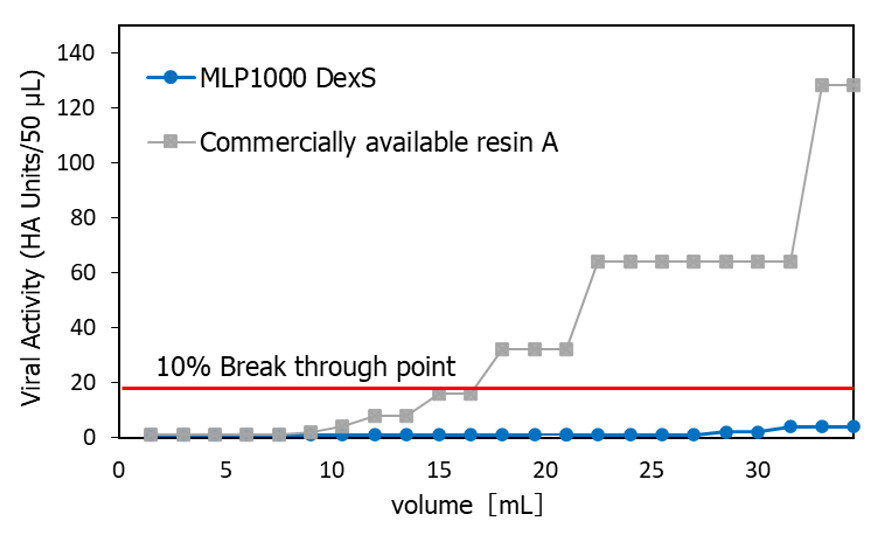Introduction of developed products:
Cellulose resin MLP1000 DexS
What is Cellulose resin MLP1000 DexS?
The cellulose resin MLP1000 is a highly crosslinked cellulose particle that has a large continuous pore structure. In the purification of large virus and virus-like particles, the intraparticle surface of the resin can be used as an adsorption site, so the MLP1000 DexS exhibits high binding capacity and purification capabilities.
How to request products under development
The Cellulose resin
MLP1000 DexS is an under developing product. The quality of the Cellufine which are chromatography media are guaranteed by ISO 9001, but the quality of this product is subject to change as it is under development.
This product is not sold. We provide a small amount of samples as a developing product. For pharmaceutical companies, diagnostics companies or other manufacturing companies and researchers who would like to handle this product for manufacturing process, we will provide samples those who consenting to above fact.
Please contact the following for sample requests.
Cellulose resin MLP1000 DexS
The cellulose resin MLP1000 is a highly crosslinked cellulose particle that has a large continuous pore structure. In the purification of large virus and virus-like particles, the intraparticle surface of the resin can be used as an adsorption site, so the MLP1000 DexS exhibits high binding capacity and purification capabilities.


Table 1 shows the characteristics of the cellulose resin MLP1000 DexS.
| Base resin | Cross linked cellulose |
|---|---|
| Particle size | Ave.90μm (40 – 150 μm) |
| Ligand | Dextran sulfate |
| Pressure | < 0.3MPa |
Table 1 Characteristics of MLP1000 DexS
The cellulose resin MLP1000 DexS is a highly crosslinked cellulose particle. Despite having extremely large open pores for virus particles to enter, the resin has high pressure resistance and can be used in large columns for the production of biopharmaceuticals.

Example of Purification of Inactivated Influenza Virus
Chromatography purification was performed using allantoic fluid containing influenza virus H1N1.

Column: I.D. 5.0 x 15 mm (0.3 mL)
Load sample: Allantoic fluid from chicken egg containing inactivated influenza virus
Virus strain: A/Hyogo/YS/2011(H1N1)
Flow rate:0.5 ml/min(150 cm/h、R.T. 0.6 min)
Equilibration: 10 mM Na phosphate, 120 mM NaCl, pH 7.4
Wash: 10 mM Na phosphate, 120 mM NaCl, pH 7.4
Elution: 10 mM Na phosphate, 2 M NaCl, pH 7.4
| Process | Volume [mL] | Virus activity [HA Value] | Proteins [µg] | dsDNA [µg] | Recovery % |
|---|---|---|---|---|---|
| Allantoic fluid | 20 | 99,600 | 10,100 | 6.4 | 100 |
| Flow through | 20 | 400 | 9,220 | 3.6 | 1 |
| Wash | 6 | 1,560 | 786 | 0.3 | 2 |
| Elution | 1.5 | 92,880 | 975 | 1.4 | 93 |
Table 2 Purification results of inactivated influenza virus
With chromatography using the cellulose resin MLP1000 DexS, the liquid volume was reduced from 20 mL to 1.5 mL and the virus could be concentrated up to 13-fold. The amount of protein impurities was reduced from 10,100 µg to 975 µg, resulting in a 90.3% reduction. It was also able to reduce the amount of dsDNA to 22% as well.
Example of Purification of Human coronavirus OC43
Human coronavirus OC43 (hCoV OC43) is a common cold-causing virus of approximately 100 nm in size belonging to the same beta coronavirus genus as SARS-CoV-2 that causes COVID-19 infection. We present an example of the purification of human coronavirus OC43 cultured in Vero cells by chromatography.

Column: I.D. 5.0 x 15 mm (0.3 mL)
Load sample: Cell culture supernatant fluid containing inactivated hCoV OC43
Flow rate:0.3 ml/min(90 cm/h、R.T. 1.0 min)
Equilibration: 10 mM Na phosphate, 150 mM NaCl, pH 7.4
Wash: 10 mM Na phosphate, 150 mM NaCl, pH 7.4
Elution: 10 mM Na phosphate, 2 M NaCl, pH 7.4
Elution 1:gradient (0→25%), 25 CV
Elution 2:isocratic (100%), 10 CV
| Process | Volume [mL] | Virus activity [HA Value] | Proteins [µg] | dsDNA [µg] | Recovery % |
|---|---|---|---|---|---|
| Supernatant fluid | 34.5 | 120,186 | 6,394 | 52.79 | 100 |
| Flow through | 34.5 | 1,020 | 4,376 | 55.53 | 0.8 |
| Wash | 4.5 | 90 | 57 | 2.25 | 0.1 |
| Elution (gradient, isocratic) | 10.5 | 108,990 | 170 | 4.95 | 91 |
Table 3 Purification results of inactivated human coronavirus OC43
With the chromatographic purification using the cellulose resin MLP1000 DexS, the amount of protein impurities was reduced from 6394 µg to 170 µg, resulting in a 97.3% reduction. It was also able to reduce the amount of dsDNA to 9% in the viral elution fraction, achieving a final virus recovery rate of 91%, which showed a high recovery performance.
Subscription for
email newsletter
Registration for the email newsletter "Cellufine News," which will deliver new product information, technical information useful for bioprocess development, and event information as soon as it arrives.
Inquiry
is here
For product inquiries, sample information, etc., please contact us here.
